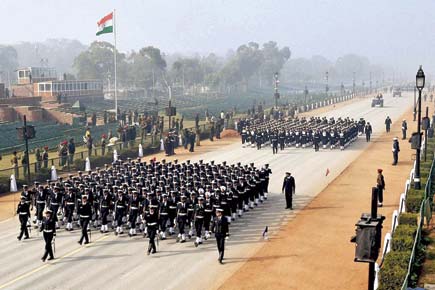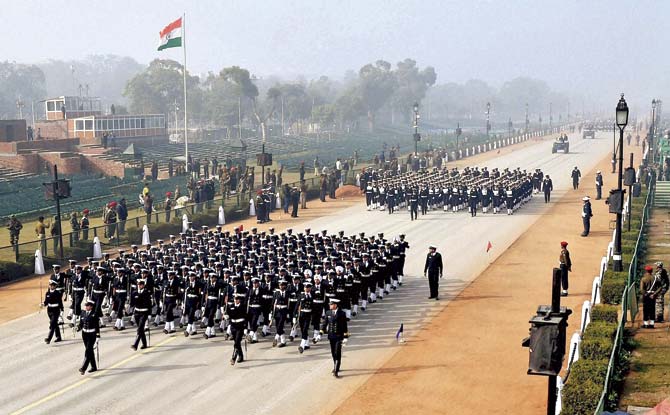There has been a certain element of surprise in India’s invitation to US President Barack Obama to be the first American to be a chief guest at the Republic Day parade next week

 There has been a certain element of surprise in India’s invitation to US President Barack Obama to be the first American to be a chief guest at the Republic Day parade next week. After all, he is now a lame-duck president of a country where both houses of Congress are in the control of the Opposition.
There has been a certain element of surprise in India’s invitation to US President Barack Obama to be the first American to be a chief guest at the Republic Day parade next week. After all, he is now a lame-duck president of a country where both houses of Congress are in the control of the Opposition.
But, in democracies, foreign policies don’t change with a change in government. Perhaps there are changes in emphases. Prime Minister Narendra Modi has emphatically indicated that good and close relations with the United States will form the core of his global policy. In the short time he has been in power, Modi has met Obama thrice — during his visit to the US in September, at the East Asia and G-20 summits in Myanmar and Australia respectively. An indication of his thrust are the close ties that the Modi government is building with two key Asia-Pacific allies of the US — Japan and Australia. China may be awash with investible cash, but so are Japanese and American private companies, and the Prime Minister hopes that his ambitious economic programme will find favour with them.
ADVERTISEMENT
 Marching contingents rehearse for the Republic Day parade in New Delhi, where US President Barack Obama will be the chief guest on January 26. Pic/PTI
Marching contingents rehearse for the Republic Day parade in New Delhi, where US President Barack Obama will be the chief guest on January 26. Pic/PTI
Ties between India and the US are often expressed in overarching terms as relations between the two great democracies and so on. But the reality is that there is a transactional element to them as well. Both sides seek to maximise their national interests, whether it is in trade, investment, or strategic links.
India’s problem has been that it has neither a product like oil which is considered strategically vital, nor does it have an ideology like Communism or Islamism which can scare the world. Son in the past, the relationship has mainly figured the US helping India, whether it was in helping us reform our education system in the 1950s and 1960s, providing food aid and later technology assistance to trigger the Green Revolution, or to hold our hands when we were defeated by China in the 1962 war. India was also the victim of US policy in this period, mainly in relation to Pakistan which used the American connection to offset India’s natural geopolitical authority in South Asia.
India’s advantage is that unlike China, which is number one in the list of nations that want to replace the US as a world power, India is a number two, and a distant one at that. Unlike China which has begun to benchmark itself against the United States as a world power, India is finding it difficult to barely maintain its hold on South Asia.
When the US looks at the Indian economy and its potential, it sees a country with whom it would like closer economic ties, a place where their investment can get good returns, and their products find a market. As a global power, coping with a rising China, India comes to American minds as well when they think of their Asian pivot. While allies like Japan and Australia are important, neither of them are big enough to offset China’s enormous geopolitical pull. Only India with its billion plus population, geographic spread and economic trajectory can do that. An Asian pivot minus India simply lacks any credibility.
In return, the US has made it very clear that they would do everything in their power to make India into the kind of world power it wants to be. This could be through greater technology transfer and economic partnerships that could bring prosperity in India. It could also be assisted through the transfer of strategic US military products which are some of the best in the world.
Friendship with the world’s sole superpower is not something to be sneezed at. It is not just the direct benefits that matter, but also the indirect ones. In the 2000s, good ties between India and the US played a great role in smoothening New Delhi’s relationship with the ASEAN, Japan and Australia. Even now, you can be sure that unless India works out a satisfactory problem to the nuclear liability issue, there will be little or no movement in New Delhi’s negotiations for a civil nuclear deal with Japan.
But we need to do a lot of homework before we can exploit the full potential of the relationship with the US. First and foremost are the structural changes needed to promote the ease of doing business in India. This is something that is not US specific, indeed, some of its biggest beneficiaries will be Indian corporates as well. Second, we need to provide the Americans satisfaction on the nuclear liability issue. Because riding on that are other benefits such as the American assistance in becoming part of a number of global technology cartels — the Missile Technology Control Regime, the Australia group on chemical weapons and the Wassenaar arrangement that restricts export of conventional weapons. Without these agreements, technology ties with the US will remain constrained because virtually everything today has dual applications — military and civil.
There is an asymmetry between India and the US — one the world’s greatest power, a rich country, and the other a weak and poor South Asian nation. India is not in much of a position to demand anything of the US. But New Delhi can drive a hard bargain and ensure that the US does not tilt the playing field entirely in its own favour. So whether it is the climate change issue, the contentions relating to intellectual property rights, or ties with China, India can play hardball to further its own interests because the US needs close ties with India to ensure a favourable balance of power for its friends and allies. For us, this is a great opportunity to use the US connection, just as the Chinese did in the 1980s to ride to world power status.
The writer is a Distinguished Fellow, Observer Research Foundation, New Delhi
 Subscribe today by clicking the link and stay updated with the latest news!" Click here!
Subscribe today by clicking the link and stay updated with the latest news!" Click here!







